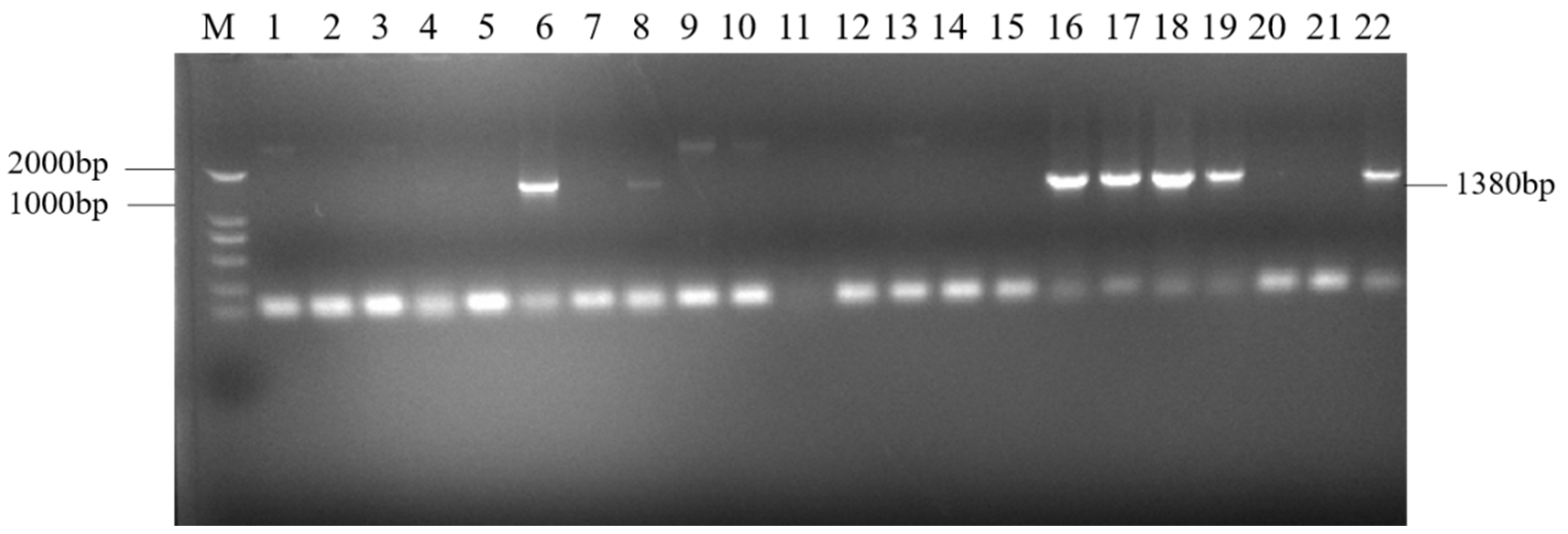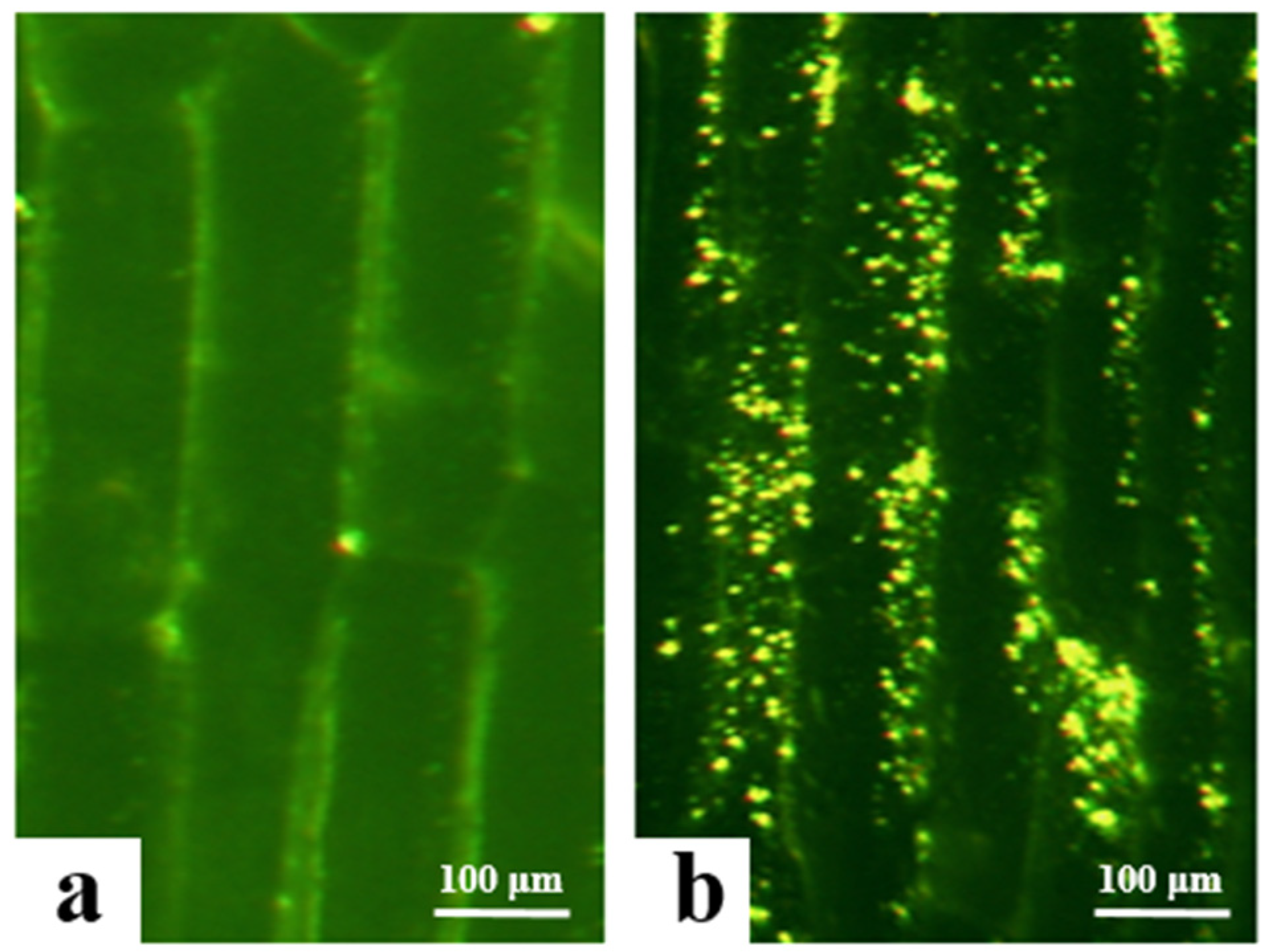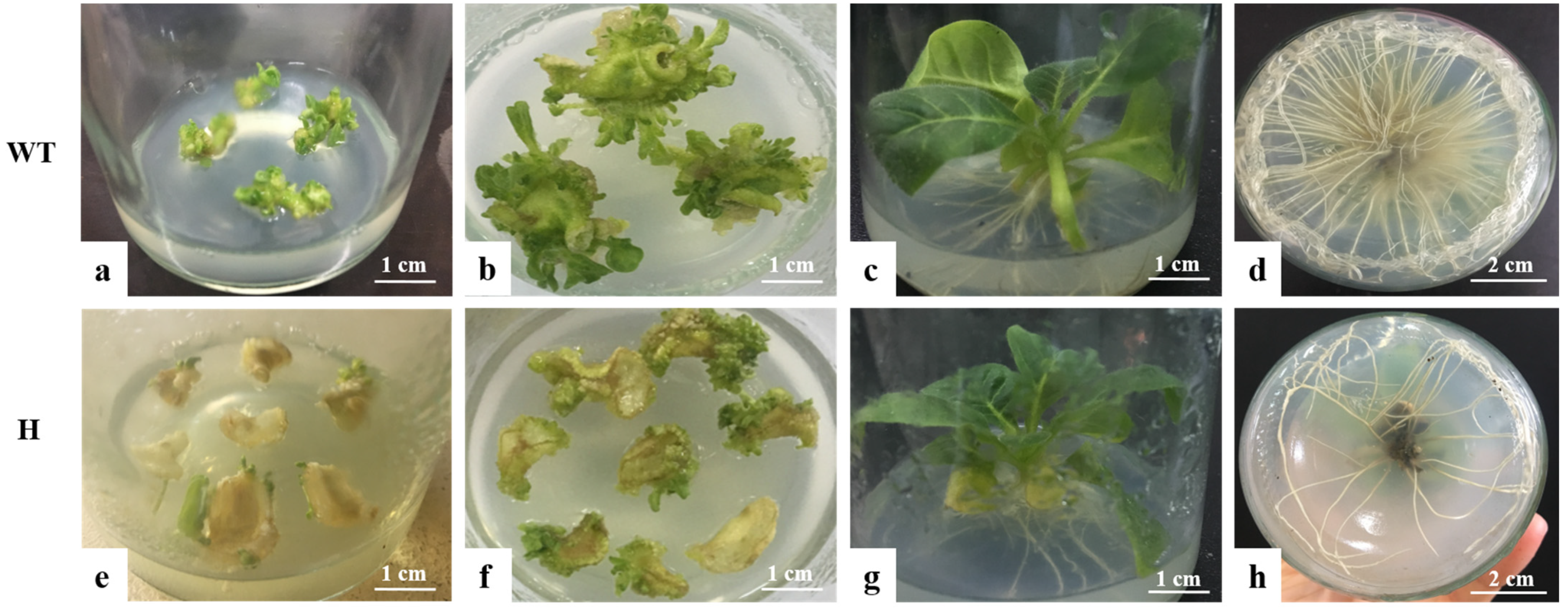Molecular Cloning and Heterologous Expression of the Mitochondrial ATP6 Gene from Kenaf (Hibiscus cannabinus) in Tobacco (Nicotiana tabacum)
Abstract
:1. Introduction
2. Materials and Methods
2.1. Experimental Materials
2.2. Experimental Methods
2.2.1. Primer Synthesis
2.2.2. Construction and Transformation of the Multi-Fragment atp2-1-atp6-EGFP Fusion Gene Overexpression Vector
3. Results
3.1. Cloning of the Target Genes
3.2. Results of the Overexpression Vector Construction
3.3. Analysis of Subcellular Localization in Onion Epidermal Cells
3.4. Agrobacterium-Mediated Transformation of Tobacco Leaf Discs
3.5. Identification of Positive Transgenic Tobacco Plants
3.6. Observations of the Phenotypic Traits and Fertility of Transgenic Tobacco
4. Discussion
5. Conclusions
Author Contributions
Funding
Institutional Review Board Statement
Informed Consent Statement
Data Availability Statement
Conflicts of Interest
References
- Li, D.F. New applications and comprehensive development of red/jute hemp and international cooperation. China Jute Sci. 2007, 29, 411–414+419. [Google Scholar]
- Tao, A.; Zhang, X.; Qi, J. Progress in the comprehensive utilization of kenaf and prospects for industrialization. China Jute Sci. 2007, 29, 1–5. [Google Scholar]
- Shi, C.; Bai, Y.; Yu, C. Optimization and development of yellow and red hemp resources. China’s Fiber Crops 2001, 23, 41–44. [Google Scholar]
- Kim, Y.; Zhang, D. Molecular control of male fertility for crop hybrid breeding. Trends Plant Sci. 2018, 23, 53–65. [Google Scholar] [CrossRef]
- Chen, L.; Liu, Y. Male sterility and fertility restoration in crops. Annu. Rev. Plant Biol. 2014, 65, 579–606. [Google Scholar] [CrossRef]
- Li, D.F. Cultivation of Kenaf Male Sterility and Utilization of Heterosis. Ph.D. Dissertation, Chinese Academy of Agricultural Sciences, Beijing, China, 2012. [Google Scholar]
- Zhou, R. Discovery of kenaf male sterility. Sci. Agric. Sin. 2002, 35, 212. [Google Scholar]
- Zhou, R.; Zhang, X.; Zhang, J.; Gan, Z.; Wei, H. Breakthroughs in the breeding of red hemp cytoplasmic male sterile lines and the utilization of hybrid vigor. Sci. Agric. Sin. 2008, 41, 314. [Google Scholar]
- Liu, H.; Zhou, R.; Xu, L. Studies on the photoperiodic response characteristics of photo-sensitive female sterility in Boehmeria nivea (L.) Gaud. Acta Agron. Sin. 2003, 29, 222–224. [Google Scholar]
- Dieterich, J.H.; Braun, H.P.; Schmitz, U.K. Alloplasmic male sterility in Brassica napus (CMS ‘Tournefortii-Stiewe’) is associated with a special gene arrangement around a novel atp9 gene. Mol. Genet. Genom. 2003, 269, 723–731. [Google Scholar] [CrossRef]
- Dewey, R.E.; Timothy, D.H.; Levings, C.S., 3rd. Chimeric mitochondrial genes expressed in the C male-sterile cytoplasm of maize. Curr. Genet. 1991, 20, 475–482. [Google Scholar] [CrossRef]
- Dewey, R.E.; Timothy, D.H.; Levings, C.S. A mitochondrial protein associated with cytoplasmic male sterility in the T cytoplasm of maize. Proc. Natl. Acad. Sci. USA 1987, 84, 5374–5378. [Google Scholar] [CrossRef] [PubMed]
- Handa, H.; Gualberto, J.M.; Grienenberger, J.M. Characterization of the mitochondrial orfB gene and its derivative, orf224, a chimeric open reading frame specific to one mitochondrial genome of the “Polima” male-sterile cytoplasm in rapeseed (Brassica napus L.). Curr. Genet. 1995, 28, 546–552. [Google Scholar] [CrossRef] [PubMed]
- Wang, H.M.; Ketela, T.; Keller, W.A.; Gleddie, S.C.; Brown, G.G. Genetic correlation of the orf224/atp6 gene region with Polima CMS in Brassica somatic hybrids. Plant Mol. Biol. 1995, 27, 801–807. [Google Scholar] [CrossRef] [PubMed]
- Wang, K.; Gao, F.; Ji, Y.; Liu, Y.; Dan, Z.; Yang, P.; Zhu, Y.; Li, S. ORFH79 impairs mitochondrial function via interaction with a subunit of electron transport chain complex III in Honglian cytoplasmic male sterile rice. New Phytol. 2013, 198, 408–418. [Google Scholar] [CrossRef] [PubMed]
- Jing, B.; Heng, S.; Tong, D.; Wan, Z.; Fu, T.; Tu, J.; Ma, C.; Yi, B.; Wen, J.; Shen, J. A male sterility-associated cytotoxic protein ORF288 in Brassica juncea causes aborted pollen development. J. Exp. Bot. 2012, 63, 1285–1295. [Google Scholar] [CrossRef]
- Landgren, M.; Zetterstrand, M.; Sundberg, E.; Glimelius, K. Alloplasmic male-sterile Brassica lines containing B. tournefortii mitochondria express an ORF 3′ of the atp6 gene and a 32 kDa protein. off. Plant Mol. Biol. 1996, 32, 879–890. [Google Scholar] [CrossRef]
- Li, G. Analysis of Mitochondrial Proteomic Differences and Discovery of Sterility-Related Genes in Cytoplasmic Male Sterility of Kenaf (Hibiscus cannabinus L.). Ph.D. Dissertation, Guangxi University, Nanning, China, 2009. [Google Scholar]
- Zhao, Y.; Liao, X.; Zhou, B. Mutation in the coding sequence of atp6 are associated with male sterile cytoplasm in kenaf (Hibiscus cannabinus L.). Euphytica 2016, 207, 169–175. [Google Scholar] [CrossRef]
- Liao, X.; Wei, M.; Aziz, K.; Zhao, Y.; Kong, X.; Zhou, B.; Li, M.; Peng, S.; Fazal, M.; Abid, U.; et al. Comparative analysis of mitochondrial genome and expression variation between UG93A and UG93B reveals a candidate gene related to cytoplasmic male sterility in kenaf. Ind. Crops Prod. 2020, 152, 112502. [Google Scholar] [CrossRef]
- Luo, D.; Xu, H.; Liu, Z.; Guo, J.; Li, H.; Chen, L.; Fang, C.; Zhang, Q.; Bai, M.; Yao, N.; et al. A detrimental mitochondrial-nuclear interaction causes cytoplasmic male sterility in rice. Nat. Genet. 2013, 45, 573–577. [Google Scholar] [CrossRef]
- Li, L.; Zhang, W.; Song, L.; Hu, X.; Chen, S.; Zhao, S. Optimization of in-fusion cloning technology and its application in the construction of large fragment recombinant vectors. Prog. Vet. Med. 2014, 35, 1–7. [Google Scholar] [CrossRef]
- Kuang, F.T.; Yuan, D.Y.; Li, L.; Li, X.Q. A novel method for vector construction: Recombination-fusion PCR. Genom. Appl. Biol. 2012, 31, 634–639. [Google Scholar]
- Wei, M.; Liao, X.; Li, Z.; Zhou, B.; Zheng, J.; Kong, X.; Zhou, R. Construction and transformation of overexpression vector for the mitochondrial gene atp6 in Kenaf. Southwest China J. Agric. Sci. 2019, 32, 2740–2746. [Google Scholar] [CrossRef]
- Ji, J.; Huang, W.; Li, Z.; Chai, W.; Yin, Y.; Li, D.; Gong, Z. Tapetum-specific expression of a cytoplasmic orf507 gene causes semi-male sterility in transgenic peppers. Front. Plant Sci. 2015, 6, 272. [Google Scholar] [CrossRef]
- Ichihara, Y.; Kurosawa, Y. Construction of new T vectors for direct cloning of PCR products. Gene 1993, 130, 153–154. [Google Scholar] [CrossRef] [PubMed]
- Fan, S.H.; Hao, W.J.; Hua, W.; Chen, Y.Q.; Yang, Z.F. Vector construction and transformation of the mitochondrial functional unknown gene ORF117 in Brassica napus L. Amino Acids Biot. Resour. 2015, 37, 43–51. [Google Scholar]
- Li, M.; Yang, Q. A highly efficient method for constructing homologous recombination DNA fragments—Fusion PCR. China Biotechnol. 2007, 27, 53–58. [Google Scholar] [CrossRef]
- Jeff, Y.; Mike, F. Precise gene fusion by PCR. Nucleic Acids Res. 1989, 17, 4895. [Google Scholar]








| Primer Names | Primer Sequences (5′-3′) |
|---|---|
| ratp2-1 F: | tctagaATGGCTTCTCGGAGGCTTCTCGC |
| ratp2-1 R: | AGTCCTTTTCATTGCCGCTGCGGAGGTAGCGTA |
| eMTS-atp6 F: | CAGCGGCAATGAAAAGGACTATGTTTGTAAATATCATG |
| eMTS-atp6 R: | ggtaccATGAAGATTTATAGCATCATTTAAGTAAATACAG |
| PBI121 F: | GGAGAGAACACGGGGGACTCTAGA |
Disclaimer/Publisher’s Note: The statements, opinions and data contained in all publications are solely those of the individual author(s) and contributor(s) and not of MDPI and/or the editor(s). MDPI and/or the editor(s) disclaim responsibility for any injury to people or property resulting from any ideas, methods, instructions or products referred to in the content. |
© 2025 by the authors. Licensee MDPI, Basel, Switzerland. This article is an open access article distributed under the terms and conditions of the Creative Commons Attribution (CC BY) license (https://creativecommons.org/licenses/by/4.0/).
Share and Cite
Huang, B.; Wei, M.; Wei, R.; Hou, W.; Tang, X.; Zhao, Y.; Liao, X.; Zhou, R. Molecular Cloning and Heterologous Expression of the Mitochondrial ATP6 Gene from Kenaf (Hibiscus cannabinus) in Tobacco (Nicotiana tabacum). Genes 2025, 16, 479. https://doi.org/10.3390/genes16050479
Huang B, Wei M, Wei R, Hou W, Tang X, Zhao Y, Liao X, Zhou R. Molecular Cloning and Heterologous Expression of the Mitochondrial ATP6 Gene from Kenaf (Hibiscus cannabinus) in Tobacco (Nicotiana tabacum). Genes. 2025; 16(5):479. https://doi.org/10.3390/genes16050479
Chicago/Turabian StyleHuang, Bangbang, Meiling Wei, Rongchang Wei, Wenhuan Hou, Xingfu Tang, Yanhong Zhao, Xiaofang Liao, and Ruiyang Zhou. 2025. "Molecular Cloning and Heterologous Expression of the Mitochondrial ATP6 Gene from Kenaf (Hibiscus cannabinus) in Tobacco (Nicotiana tabacum)" Genes 16, no. 5: 479. https://doi.org/10.3390/genes16050479
APA StyleHuang, B., Wei, M., Wei, R., Hou, W., Tang, X., Zhao, Y., Liao, X., & Zhou, R. (2025). Molecular Cloning and Heterologous Expression of the Mitochondrial ATP6 Gene from Kenaf (Hibiscus cannabinus) in Tobacco (Nicotiana tabacum). Genes, 16(5), 479. https://doi.org/10.3390/genes16050479






